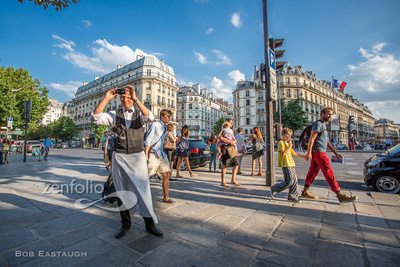Realism and Photography, Part Three; September 2017
To recap, an inherent problem in discussing realism in context of photography is defining what is "real." The last two posts discussed reality in terms of whether the finished product (print or digital file as shown on screen) was "the same" as what a human observer would have seen. Ignore technical differences that endow a camera with abilities that eyes and humans don't have (such as abilities to freeze fast action - the speeding bullet, the waterdroplet - or to make visible something very distant or very tiny or very dark). Those two posts discussed images that a human observer couldn't possibly have seen in the same way (because the photographer later imported a moon into a moonless night scene, for example) - classic Photoshopping.
But there is potentially a more interesting and subtle distinction. Start with the fact a photograph records a scene at a specific moment in time. That moment is gone forever, except in human memory or unless it is somehow electronically or chemically or mechanically preserved, as on film or digitally. That moment is "reality" but it is ephemeral and now long gone. If the moment depicted part of a continuous event, part of a skier's race run, for example, it might have lasted only 1/2000th of a second. At that shutter speed, if the run lasted 50 seconds, 100,000 different photos could have been taken of that run. But in truth, the entire run is now history, and it doesn't exist. The racer has skied to the bottom of the hill, hung up her skis, taken off her boots, eaten dinner, gone to bed, and gotten up for another day of racing or thinking about racing. Likewise, Stieglitz's New York City snowstorm is long over and Cartier-Bresson's jumping children have long since come back to earth, gone in for supper, grown up, survived the war (we hope), married, had children, and lived many more years (we hope). Are the moments those images depicted truly "real" now that they are gone?


One/two-thousandth of a second, and thus 1/90,000th of the racer's 45-second slalom run in 2013. She skied down, took a second run, collected her trophy, flew home, graduated from high school, and went on with life. The moment depicted is gone. Is it real? Does it matter?
Here is where Susan Sontag's brilliance saves us from avoidable, logical headaches. She discusses (in her words) Plato's "derogatory attitude toward images" as "shadows . . . impotent co-presences of the real things which cast them." (Sontag, On Photography, at 179-80, 1973). Rejecting the distinction Plato drew, she instead reasons that "the force of photographic images comes from their being material realities in their own right, richly informative deposits left in the wake of whatever emitted them, potent means for turning the tables on reality -- for turning it into a shadow." (Id. at 180) To her, the original moment, person, or event is now the shadow, and the captured image is now the reality. In effect, asking whether it is the moment or the image that is "real" raises the wrong question. As to photography, the ultimate question for her is whether the print (she wrote before digital photography took over) one holds in hand is itself real; since the print exists, it is real; the print defines reality in its own terms and context, in the only relevant way, in terms of the image's existence as a print. Whether the image records reality is not relevant to the aesthetic appreciation of the print. It may be relevant to its forensic value, but it isn't relevant to its aesthetic or existential value.
Here are two more examples.


This 2013 image is real, but the moment depicted is long gone. The bistro (les Deux Magots) still stands, and almost certainly the waiter still works there (he still did in 2014, when I took him a print of the image), but he has long since handed the camera back to the tourist who asked him to photograph their table, the tourist has long since returned home (but may well have returned to Paris since), all the passers-by have passed by, gone home, and grown older. And as I write this, it is nighttime in Paris, and it may even be raining.
So, reality in the photographic context ultimately turns on whether the image exists.


Contemplating the logical consequences of this thread of reasoning can be overwhelming. This 2014 photo depicts a kind, generous friend, tour guide, pro biker, and luthier who is himself no longer with us in person. His image, however, is real. Is this what Sontag means, when she says "Photography is an elegiac art. . . . Precisely by slicing out this moment and freezing it, all photographs testify to time's relentless melt."? (Id. at 15)
Comments


After a lifetime of mainly expressing myself with words, my postings here will mainly rely on images. They will speak for themselves to some extent, but I'll usually add a few comments of explanation. I've taken photographs for decades, since the 1950's, inspired in part by my father's photographic skill. Four years of photo assignments and quality darkroom time eventually gave way to decades of casual and family picture-taking. I re-immersed myself when I left film and turned to digital.